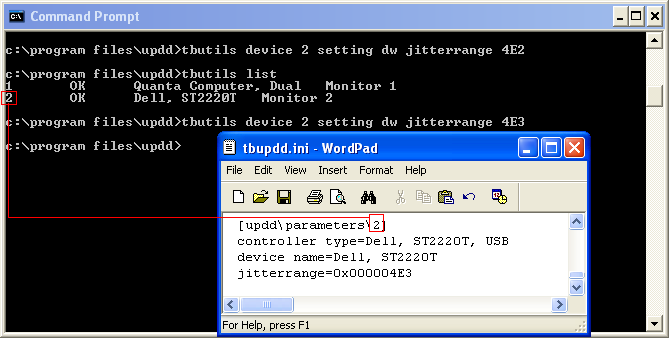Example command lines
|
Typically the command line utility is invoked from a Windows Cmd dialog or a Linux or Mac OS X terminal program, as per this Windows example:
In the above example the system has 2 UPDD devices. The Dell touch screen is on Monitor 2 and has a UPDD device handle of 2. The command has been used to change the jitterrange value for the Dell touchscreen.
Some typical examples of the use of tbutils
In the commands below, any that do not specify a Device Selector are acting on the first installed device.
|
|
|
Command |
Purpose |
|
tbutils nodevice setting dw eepromreadsilent 1 |
Suppress eeprom read dialog issued by driver when reading eeprom |
|
tbutils setting dw "Anchor Mouse" 1 tbutils nodevice setting dw "Anchor liftoff" 64 |
Return cursor to previous position after touch on device Time delay in milli-seconds to return cursor after touch - defined in Hex. Default is 3E8 (1000ms) hardcoded, 1F4 (500ms) by default in .ini file. |
|
tbutils setting dw jitterrange 4E2 |
Increase jitterrange, the value used by UPDD to calculate a stationary stylus, such as in Interactive Touch click mode. Customer could not get right click to be generated due to excessive jitter of stylus. |
|
tbutils nodevice setting dw "show systray" 0 |
Disable updd system tray option. Next time the tbdaemon task is loaded (normally at system startup) this setting determines if the system tray icons are shown. |
|
tbutils nodevice setting dw dcuselectfirstconnected 1 |
In the UPDD Console, default the selected device to the first connected USB device. |
|
tbutils setting sz "event mode 0" "Interactive Touch" tbutils setting dw “interactive touch time” 64
tbutils setting sz “event mode 0” None
tbutils setting sz "event mode 0" "Touchdown Left" tbutils setting dw Motion 0 |
Example Mouse emulation settings Set Interactive Touch and touch time for right click
No pen down/up functions (no clicks) – Stylus motion only
Click and drag mode (pen down on touch, up on lift off with no motion
|
|
|
Calibration related UPDD calibration function will set all required orientation settings if using 4 calibration points or more. However, in cases where you need to set these manually these are the settings involved: |
|
tbutils setting dw invertx 1 (or 0) tbutils setting dw inverty 1 (or 0) tbutils setting dw swapxy 1 (or 0) |
Inverts X movement Inverts Y movement Swaps both X and Y |
|
tbutils setting sz “calibration style” Custom2point tbutils setting dw “calibration points” 2 /opt/tbupddlx/upddcalib – run calibration
|
Calibration uses a text mode calibration process if the name of the calibration style is Custom2point or Custom4point. A Linux customer needed to set the settings for this calibration mode without using the UPDD Console :
|
|
tbutils setting sz hidparsemetrics N,0,0 tbcalib diag – to capture raw data |
Need to capture raw touch data for a controller that is currently set to only pass thro’ HID packets |
